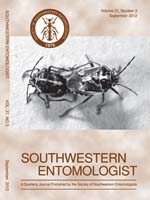Pyric-herbivory, defined as fire-driven grazing, was applied as patch-burn grazing management and compared to traditional management (grazing without fire) for the potential to mitigate horn flies, Haematobia irritans (L.), on cattle in Iowa and Oklahoma. Stocking rate was conservative at both locations, and all cattle were black angus, Bos taurus (L.). Study design was two treatments replicated three times for a total of six pastures at each location. Average pasture sizes were 27 ha in Iowa and 55 ha in Oklahoma. The primary objective was to assess response of the Eurasian origin horn fly to fire and grazing disturbances. Numbers of horn flies were assessed at both locations and analyzed for location, treatment, and interaction (location × treatment). Numbers of horn flies differed only between treatments. Patch-burn grazing management resulted in 41% reduction of horn flies, less than in the traditional management system regardless of location (P < 0.0001). Cattle in pastures managed with patch-burn grazing were near the universally accepted economic threshold for treatment (200 flies per cow) compared to double the economic threshold on cattle under traditional management. Cattle in pastures managed with patch-burn grazing were below the behavioral threshold of 300 flies per cow and were expected to have increased grazing time associated with a reduction in stress annoyance behaviors. These results demonstrated that grazing management that includes fire can reduce horn flies on cattle in rangeland systems.
How to translate text using browser tools
1 September 2012
Pyric-Herbivory to Manage Horn Flies (Diptera: Muscidae) on Cattle
John D. Scasta,
Dave M. Engle,
Justin L. Talley,
John R. Weir,
J. Chris Stansberry,
Sam D. Fuhlendorf,
Ryan N. Harr
ACCESS THE FULL ARTICLE

Southwestern Entomologist
Vol. 37 • No. 3
September 2012
Vol. 37 • No. 3
September 2012




